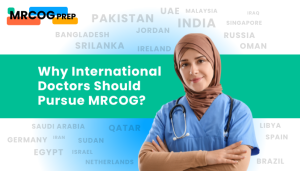Wanting a career in Obstetrics and Gynaecology (O&G) takes hard work and a promise to be the best. The mrcog qualification is an important step for any doctor who wants to work in this field. It proves you have great knowledge and skill, and it opens doors to better jobs around the world. This article explains everything about this key examination. It will cover how the exam is set up, what you need to do, and the benefits you get.
What is the MRCOG Exam?
MRCOG full form is Membership of the Royal College of Obstetricians and Gynaecologists is a highly respected qualification for doctors after medical school. It is given by the Royal College of Obstetricians and Gynaecologists (RCOG) in the United Kingdom. This qualification is respected all over the world and is the top standard for O&G doctors.
Getting the MRCOG title shows that a doctor has the right knowledge and hands-on skills to give women excellent medical care. It is a key requirement for special training in the UK, and hospitals and clinics around the world value it highly.
Understanding the Structure of the MRCOG UK Exam
The examination has three separate parts. Each part tests different skills, from basic science to real patient care skills. A doctor must pass each part one after the other to get the full MRCOG title.
MRCOG Part 1: The Foundation
MRCOG Part 1 is a written test that checks your knowledge of the basic science needed for O&G. The exam has two papers. Each paper has multiple-choice questions where you pick the one best answer. The list of topics is very long and includes many subjects.
Key subject areas include:
- Anatomy and Embryology
- Physiology and Biochemistry
- Pathology and Pharmacology
- Genetics and Endocrinology
- Microbiology and Immunology
- Biophysics and Statistics
This part makes sure doctors have a good science background before they move on to the next parts that focus on patient care.
MRCOG Part 2: Clinical Application
After passing Part 1, you can take the Part 2 written exam. This part checks if a doctor can use their knowledge in real patient situations. It tests how well a doctor can handle different O&G medical problems. The exam has two papers with multiple-choice questions.
These questions give you situations about patients, and you must pick the best thing to do or the right diagnosis. This part checks your decision-making, how you solve problems, and if you use current medical facts to treat patients.
MRCOG Part 3: Practical Skills
The last part is a practical test. It is a hands-on test called an Objective Structured Clinical Examination (OSCE). It is made to test a doctor’s skills in situations like those in a hospital or clinic.
The test is made up of different stations or rooms. In these stations, you talk to actors who play the role of patients or use medical dummies to do medical tasks.
The Part 3 exam tests many important skills, such as:
- Asking a patient about their medical history
- Performing a physical examination
- Talking with patients and other doctors
- Handling patient problems
- Keeping patients safe
This final part makes sure a doctor knows what to do and can also do it safely and well in their job.
Key MRCOG Benefits for Your Medical Career
Getting the MRCOG qualification gives you big advantages that will help your career. The mrcog benefits are more than just something to put on your CV; it is a major achievement that is known around the world.
A main benefit is that it helps you get better jobs. In the UK, you must have the MRCOG to become a senior doctor (consultant) in O&G. It is also important for getting into advanced training programs. The qualification is highly respected in other countries. This makes it easier to get jobs in Europe, Asia, and the Middle East.
Also, studying for and passing the exam greatly improves a doctor’s knowledge and skills. The hard study process makes sure doctors know the newest medical information and guidelines. This better knowledge leads to better care for patients.
Your Path to Taking the MRCOG Exam
To get the MRCOG, you need to plan carefully. Doctors who want to take the exam must meet certain requirements and follow the set steps to apply.
Checking Your Eligibility
The rules are a little different for each part of the mrcog exam. For Part 1, you need a medical degree that the RCOG accepts. You do not need work experience after medical school for this first part.
For Part 2, you must have passed Part 1. For Part 3, you must have passed Part 2. You also need to get your training approved by the RCOG. This usually means showing you have worked for a certain time in O&G.
The Application Process
You can apply for each part on the RCOG website. The application is done online. You must watch the application dates carefully, as they are announced early. You will need to send the needed papers, like a copy of your medical degree, and pay the exam fee.
Conclusion
The MRCOG qualification is a very important step for any doctor who wants a career in Obstetrics and Gynaecology. It is a complete test that proves a doctor’s knowledge and skills to a worldwide standard. The process is hard, but the benefits for your job make the hard work worth it.
